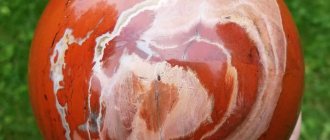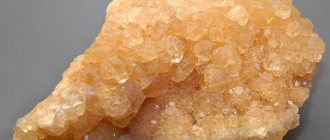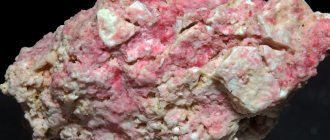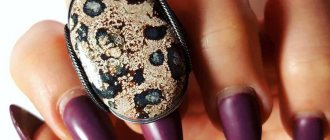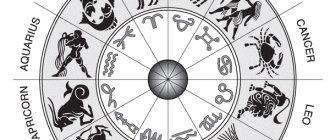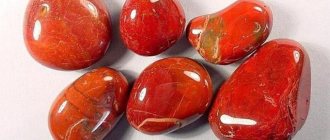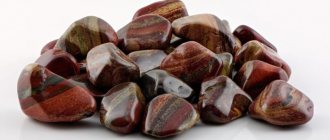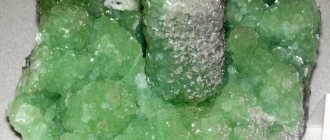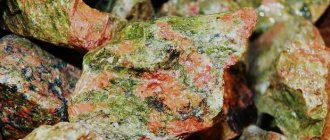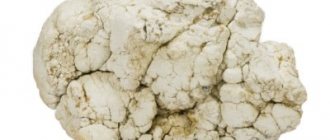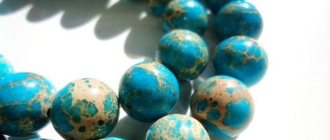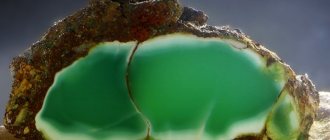Jasper – a variety of chalcedony, which is a type of quartz. Dalmatian jasper, which may also often be called Dalmatian jasper, porphyrite, porphyry or quartz diorite, are all varieties of the mineral called diorite. In appearance, this mineral is very similar to granite and has the same massive texture. The color of the stone is usually grayish-white, greenish or brown, with black spots, very similar to the color of Dalmatian dogs. This is where the common name diorite comes from.
Characteristics of the stone
The chemical formula of the gem is very complex. The main element is silicon. Its concentration reaches 60-95%. It also contains oxides of iron, calcium and aluminum.
Some copies contain:
- clay minerals;
- alkaline amphibole;
- magnesite;
- epidote;
- manganese;
- accept;
- chlorite;
- mica;
- actinolite;
- pyrite.
Characteristics of chemical and physical properties:
- belongs to the class of silicates;
- color - varied;
- shine - can be waxy, glassy, or glossy;
- pleochroism - no;
- cleavage – no;
- hardness – 6.5-7;
- syngony – triclinic;
- density – 2.6 g/cmᶾ;
- the fracture is mostly smooth, turning into conchoidal.
There are no transparent gems in nature. They have a fiber structure. The presence of all kinds of granular inclusions is noted. The shades and texture are also varied, so they often try to counterfeit another semi-precious or precious stone with the help of jasper, for example, lapis lazuli or turquoise.
Chemical and physical properties
Chemical properties of jasper
| Parameter | Meaning |
| Formula | SiO2, silicon oxide (silicon or Si in the periodic table). |
| Crystal cell | Similar to diamond, although the hardness is inferior |
| Chemical properties | Inactive, if you analyze what jasper consists of - there are no compounds that would provide violent reactions |
| Stability | Due to its low activity, jasper stone is stable and remains unchanged over a period of time estimated at millions and billions of years. |
| Compound | The composition is 90% heterogeneous; in addition to silicon oxide, the description of jasper indicates aluminum oxides, iron oxides, calcium oxides |
| Metals in content | Highly active metals in the composition of the stone are in an already oxidized state, which ensures stability among the properties of jasper and the absence of reaction with natural and chemically produced acids |
| Application | The natural mineral has historically found its use in the form of an ornamental stone, including for the manufacture of tableware - plates, spoons, bowls, teapots due to its low chemical activity. |
Magical powers were attributed to blood jasper, which contains an increased amount of iron. The properties and meanings of the jasper stone changed from culture to culture, invariably attracting the attention of mankind; the chemical, and along with them, the physical properties of the ornamental mineral played an important role.
The variety of jasper colors is amazing!
Physical properties of jasper
If we translate what the word jasper means, then the origin of the term is Turkish, meaning “speckled stone” or “motley stone”. Interesting fact: the older name of the mineral, jasper, is translated in a completely similar way, only not from Turkish, but from Greek, from which the original Slavic terms originated.
Physics, answering the question of what jasper is, explains the properties of “variegation” by the existing impurities and the formation of geological layers in the Earth’s crust - the mineral went through the stages of pressing at high temperatures, silicon was first oxidized in the core, then came out under the influence of the natural movement of tectonic plates. During the process of formation, there were many other minerals, substances, and elements nearby that gave the jasper stone properties and meanings that were later so highly valued by people. Physical properties include:
- Sedimentary volcanogenic origin, high content of garnet-like rocks, spar.
- The abundance of impurities that form in variegated gems a richness of shades, colors, and pattern variability, valued by ancient craftsmen and modern jewelers who make talismans and amulets from jasper.
- Homogeneous, single-colored stones are extremely rare, prized for making amazing jewelry, a variety of jasper of the single-color type is black, which is actually the mineral basanite. In a single-color basanite gem, there is a minimum number of sub-shades, pattern variations, transitions of shades and tones, the formation of spots, stripes, and natural flows.
The hardness of the mineral on the international Mohs scale is seven, the density is equal to 2.65 g per cubic centimeter. For the average product buyer, information is of little importance. Those who make jewelry, dishes, and handicrafts have in mind relative softness, ease of processing, but at the same time strength and the absence of fragility characteristic of carbon compounds, including diamonds.
Origin
The history of the origin of the mineral begins in the 18th century. During this period, the first mentions of it appeared in scientific works. Scientists have determined that the formation of jasper is observed in areas with increased volcanic activity.
It contains ancient algae and mollusks. Specimens have even been found that contain inclusions of various species of prehistoric oceanic fauna and flora.
During the eruption of volcanoes located under water, the inhabitants of the seas and oceans died in lava. At the same time, aluminum salts, quartz and potassium were combined in the rock. In this way an incredibly beautiful gem was formed.
The ancient name of the mineral is meat agate. Also in the old days it was known by the following names:
- japsis;
- tiger stone;
- mottled;
- Swiss lapis;
- basanite;
- jasper agate;
- bloody jasper.
The names were invented based on the color of the nugget and taking into account the place where it was mined.
From all diseases and misfortunes
The healing properties of jasper have been revered throughout the centuries. Until now, the description of a mineral given by an astrologer, lithologist or psychic necessarily contains a mention of its healing power. Medieval alchemists noticed its therapeutic properties. They used the property of this mineral to resist various caustic liquids. They identified varieties of jasper as material for vessels in which magical potions were stored.
It is a known fact that the Byzantine ruler Manuel presented a vessel in the form of a bowl as a gift to the Christians of the Athos monastery with the parting words that it resists poisons and has healing powers.
The significant popularity of the mineral as a raw material for making tableware is explained by the fact that it does not absorb water.
In ancient times, healers and sorcerers believed that bloody jasper could stop bleeding. But only a yellow pebble can get rid of stomach problems and restore a woman’s ability to conceive.
Field
The very first deposits of jasper were discovered in Ancient Egypt and India. Some of them have not yet been exhausted to this day. In the 18th century, deposits were discovered in the Urals. In 1896, one of the special varieties of gems was discovered there - Ural jasper, blue-gray in color with black veins.
The Orsk vein is now being intensively developed. The Ural mineral is also mined on Mount Colonel. The famous Muldakaevskaya and landscape jasper were discovered there. In the northern part of the Urals, the Kalkan variety is mined.
Deposits are also located in the following territories:
- Kola Peninsula;
- Madagascar;
- Switzerland;
- USA;
- Australia;
- Bashkiria;
- Ukraine;
- Mexico;
- North Caucasus;
- Venezuela;
- Germany;
- France;
- Uzbekistan.
Madagascar and Australian jasper, like Indian gems, occurs in the form of large blocks and layers. Placers are found extremely rarely.
Various-faced jasper
Like the names of many minerals, the word “jasper” has Greek roots. If you translate it literally, you get “motley stone.” It is difficult to come up with a more precise definition. Our ancestors called all jaspers as jasper or blood agate. These gems with a fibrous structure and inclusions of pyrite, garnet, and hematite lend themselves well to processing. Under Catherine the Great, entire factories were built in Russia to produce products from these minerals.
Altai and Ural jasper is found in the famous agate rooms of the Tsarskoye Selo Catherine Palace.
The Empress idolized her, spending a lot of money on geological expeditions looking for new deposits of gems. Some of them are still in effect.
Jasper gets its color from additives to silicon oxide. Its rich palette of shades excludes pure blue. But you shouldn’t use color alone as an indicator of authenticity.
The only way to recognize a natural stone is its natural spotting - stripes, stains, layers, stripes - no monotony or sparkles.
Varieties of Jasper
The stone is very changeable. It is divided into types based on color and structure. There is no single classification of such gems.
By color
Jasper comes in different colors:
- red;
- yellow;
- orange;
- brick;
- bloody;
- green;
- wax jasper (brown with a red tint);
- blue;
- purple;
- blue;
- lilac;
- white;
- gray jasper;
- pink;
- black.
Most often found in nature are yellow-brown, grayish and green minerals. Among the rarest varieties are purple and blue gems.
By structure
Minerals are classified by structure as follows:
- breccia jasper – represents angular fragments cemented with each other;
- concentric;
- homogeneous - quite rare;
- calico;
- breccia-shaped - the gem is similar to breccia, but not so variegated;
- fluidic;
- spotted
Varieties names
Most varieties have their own original names:
- agate – the presence of stripes characteristic of agate is noted, but in this mineral they are not so clear;
- tape;
- basanite is a fine-grained black mineral;
- sand jasper - valued for its incredibly beautiful landscape design;
- Swiss or German lapis - used to imitate lapis lazuli;
- prazem - a green-colored gem with a high concentration of quartz;
- Nunkirchen - a fine-grained gray-brown mineral, its deposits are found exclusively in Germany;
- ocean stone - acquired this name for its special pattern reminiscent of the seabed;
- calico – the texture is fine-grained, but the presence of coarse-grained inclusions of chalcedony and quartz is noted;
- tiger mineral;
- leopard print – the gem is distinguished from other species by its unusual leopard print color;
- motley;
- Dalmatian jasper or simply Dalmatian - a spotted stone similar in color to the coat of a dog of the same breed, which is why it was called Dalmatian jasper;
- imperial - the color is bright blue, there are beige veins on the surface;
- Picasso jasper - a patterned ornament with chaotic intersecting lines, similar to the masterpieces of abstractionists;
- bamboo;
- sand - a rare mineral, the gem is mined only in the territory of Bashkiria;
- jasper mukaite – mined in Australia;
- crocodile – the pattern on the surface of the gem is similar to the skin of a crocodile;
- irnimite - in orange, cherry or gray colored rocks, the presence of blue and purple veins is noted;
- unakite – has a green color interspersed with brown and pink;
- Kushkuldinskaya and Aushkulskaya (also called dendritic for their similarity with dendrites) - mined exclusively in the south of the Urals;
- Chohua - reminiscent of unusually beautiful Chinese engravings;
- Kambaba - differs from other species in its unusual color; dark green tints are noted on a black background;
- woody - a coffee-au-lait color mineral, which is permeated with a pattern similar to the annual rings of trees;
- patterned;
- Revnevskaya – deposits are located in Altai;
- tortoiseshell - has a frankly black, dark shade, an extraordinary tortoiseshell pattern is noticeable on it;
- bumblebee or bee gem - it is made from eclipse and has an unusual color. This is an artificial, not natural stone.
Unakit
Picasso
Bee
Differences between the original and the fake
Many women want to buy a stone, but often they buy a fake. You can only order jewelry from popular jewelry stores or well-known online sites.
You can distinguish the original by several characteristics:
- There are only three main types of stone on sale - green, white and red, and jasper of unusual colors is most likely to be of artificial origin;
- the original material has high hardness, a shiny surface with a clear pattern, while the synthetic type has a blurred structure;
- the fake is made of glass, acrylic or plastic, so if damaged, scratches and cracks form on it, and natural rock can be dropped onto a hard floor;
- the fake is deformed when heated, nothing will happen to the natural stone;
- the mineral does not heat up on the human body, and the artificial crystal will quickly become warm;
- a real mineral has significant mass even with a small size.
Experts do not recommend buying jasper in online stores, as the description may be inaccurate, although the stone will look natural. Before purchasing, you need to carefully study its structure.
Medicinal properties
Jasper is important for humans. Stone therapy using it has been popular for many centuries. Healing stones have a positive effect on the body. Chinese healers are convinced that they prolong life and relieve depression.
The following medicinal properties of the gem are distinguished:
- dulls pain and facilitates childbirth;
- helps in the fight against colds;
- prevents epileptic seizures;
- relieves fever;
- normalizes the psycho-emotional state;
- treats chronic diseases;
- eliminates insomnia;
- “drives away” nightmares;
- prevents vision deterioration;
- dulls toothache.
Depending on the shade, each mineral is intended for different purposes:
- red – has a positive effect on the functioning of the heart and vascular system;
- green – eliminates problems associated with the gastrointestinal tract;
- yellow – has a sedative and analgesic effect.
History of the mineral
Historically, jasper rock deposits were formed where the sea gradually gave way to mountains due to earthquakes, tectonic plate shifts, volcanic eruptions and other natural phenomena.
As a result of these processes, lava, stones and organic remains of marine flora and fauna mixed and compacted, which became the cause of the formation of multi-colored rocks.
Depending on the nature of the initial conditions, the chemical composition and appearance of stones in deposits around the world differ.
Man has used jasper since ancient times. Primitive people used it to create tools and tools. Over time, when the urgent need for survival disappeared and culture and art began to develop, various jewelry began to be made from the mineral and used in construction and decoration.
Magic properties
The special significance of the stone is noted in magic. Rainbow jasper is a powerful amulet. The following magical properties of the mineral are distinguished:
- removal of damage and the evil eye - dark specimens with the shape of a ball are considered the strongest;
- getting rid of negative energy - stones containing hematite have a similar effect;
- improving relationships with others;
- restoration of justice;
- protecting babies from external negativity - acts as a powerful amulet;
- accumulation of internal energy - if necessary, the stone transfers it to its owner;
- strengthening self-confidence, sense of honor and duty;
- discovery of the secrets of existence;
- attraction of luck;
- activating dormant talents and helping to achieve success at work;
- attracting prosperity and happiness to the home;
- concentration;
- endowment with wisdom.
In Rus', it has long been believed that this gem signifies strength of spirit. In Egypt, it was used as an amulet that could help prove one’s case in a dispute.
Who is suitable according to their zodiac sign?
The elements of the gem are Earth and Air, and the patron planets are Jupiter and Mercury. Jasper is ideal for Virgo according to the zodiac sign. It has the following effects on them:
- relieves boredom;
- eliminates the passion for teaching;
- helps you become more reasonable.
The horoscope compatibility of jasper with such a zodiac sign as Capricorn is also noted. Only in this case should you abandon dark shades. Taurus people can also wear jewelry with jasper. Under their influence it will be possible to gain flexibility of thinking.
The gem is considered the patron of creative individuals, so it is suitable for Aquarius and Gemini.
A talisman with such a stone is recommended for people born under the zodiac sign Libra.
There is a positive impact on Leo and Sagittarius. But the mineral can cause harm to Aries. By wearing such jewelry, a person risks turning into a loser.
Jasper has good compatibility with Pisces and Scorpios. For Cancers, a gem is useful only if it is white, light green or blue. Red ones are absolutely not suitable for them.
Application
Ornamental and semi-precious stones have found application in various fields. The unprocessed mineral does not look aesthetically pleasing, so it takes a long time to refine it using complex technology. Thanks to this procedure, the gem becomes resistant to mechanical damage and retains its original appearance for many years.
Ornamental jasper is used for interior decoration. It is made from:
- vases;
- figurines and figurines;
- chests of drawers;
- a table clock;
- candlesticks;
- boxes.
The stone is used for making countertops and facing fireplaces. The mineral is also widely used in jewelry. Most often it is combined with gold, silver or tin.
Caring for mineral products
To ensure that the product retains its appearance and beauty, please read the care instructions:
- Store jasper jewelry separately from other jewelry. But this rule applies to every precious stone.
- Do not drop the product as it may break or crack. Therefore, you cannot knock on jasper coverings.
- Protect from exposure to alkalis, cosmetics and detergents.
- Do not let the jasper product fall into the fire, do not keep the figurine on the windowsill. Direct rays should not hit the figurine or decoration.
To clean the gem, just wipe it with a soft cloth. If necessary, soak a rag in a solution of water and vinegar. But the solution must be weak. As a rule, jasper inserts do not need polishing. The gem is hard and difficult to damage.
How to wear and care
Caring for jewelry with this stone is not particularly difficult. You just need to adhere to the following recommendations:
- store in a box or casket, lined with soft fabric on the inside;
- avoid overheating, sudden temperature changes and contact with open fire;
- do not keep in water for a long time;
- keep away from perfumes and cosmetics.
If the jewelry becomes dirty, wash it in a soapy solution using a soft sponge. It is also possible to add a small amount of vinegar to the composition. At the end of the procedure, the mineral is rinsed in plain water, dried and polished with suede. No cleaning agents are used.
Many people clean with ultrasound. Once every six months you can use special products that are designed to care for gems.
Jewelry created using jasper is considered universal. It is advisable for women and young ladies to choose light shades. For men and older people, dark stones are the optimal solution.
It is not customary to display amulets and talismans on display. They are hidden under clothes, in a pocket or purse.
The stone has powerful energy, so wearing it constantly is not recommended.
Talismans and amulets
Jasper is used to create magical amulets and other jewelry that can protect the owner from various kinds of problems.
Talismans and amulets made from this stone:
- protect from damage and the evil eye;
- protect hiding places from thieves and ill-wishers;
- repel envy and jealousy - this property is especially well expressed in untreated stone;
- protect against animal attacks.
Both a jasper decoration and a stone placed in a pocket or sewn into clothing can serve as a talisman.
Protective amulet.
How to spot a fake
This stone is inexpensive, so it is extremely rarely counterfeited. Often, jasper is used to imitate amazonite, jade or turquoise. Despite this, there are still craftsmen who manage to create a synthetic copy of the mineral.
It is quite simple to distinguish real jasper from fake:
- the structure of the stone is dense, there is a clear pattern and silky shine, there are small flaws on the surface;
- a natural gem does not break when dropped on the floor and remains unharmed;
- with slight heating, the fake is deformed;
- if you hold the mineral in your hand, it remains cold and does not heat up;
- Regardless of size, a natural gem cannot be weightless.
Cost and favorable time to purchase
The cost of a stone depends on its color, chemical composition, degree and complexity of processing. A small sample of uncut jasper will cost 40-100 rubles.
A processed mineral in the form of a drop, circle or oval will cost 20-200 rubles.
The price of individual collectible samples with unusual colors and rare impurities reaches up to 1000 rubles. and more. For example, kambaba (crocodile-colored stone) can cost from 2,500 rubles. for 1 copy.
The most favorable time for purchasing red or pink jasper is the 6th lunar day, blue or blue - the 8th, black - the 10th. It is best to purchase stones of other types and colors on the 15th day of the calendar. They begin to use the product no earlier than 2 weeks after purchase.
Interesting Facts
The mineral has been widely used for many centuries. There are many interesting facts associated with it:
- According to Mikhail Lomonosov, jasper is one of the most important goods in Russia. He compared its value to pearls, crystal and amber.
- Alexander Sergeevich Pushkin wore a green jasper bracelet without taking it off. The poet considered him an assistant in amorous affairs.
- The interiors of the Kremlin palaces are given a special flavor by paintings created from grayish-blue and light blue gems.
- The Hermitage houses a unique exhibit - “The Queen of Vases”. It weighs 19 tons and is 5 meters in diameter. It was carved from green stone with a ribbon pattern.
- The maces of Bohdan Khmelnytsky and Khan Amin were made from this material.
- A five-ton block of green stone was used for a Buddha statue, which is located in one of the Thai temples. According to legend, healing energy of enormous power emanates from it.
- Baron Rothschild received four hundred thousand rubles in gold for a box made from this material.
- The Byzantine Emperor Manuel presented a jasper bowl to the Athonite monks. This priceless gift helped to heal from all diseases and neutralize poisons.
Not every professional can name all types of jasper. But anyone who has ever seen this gem will be delighted by its beauty. Despite the apparent simplicity, all specimens are unique and perfect.
Where can I buy the product
Pure, unpolished or already processed jasper can be purchased in souvenir or feng shui shops. They also sell products made from this material (from keychains and figurines to boxes and amulets).
Jewelry with cut crystal inserts can be found in many jewelry stores. Pieces can be purchased outright or custom-made to match the wearer's preferences as a ring, bracelet, earrings or necklace.
Designer ring with jasper.
